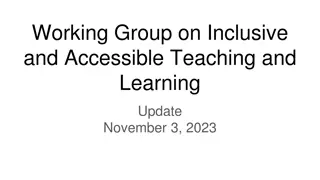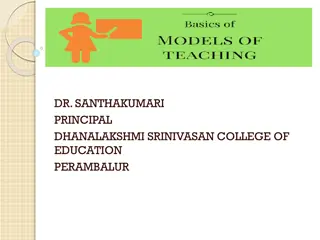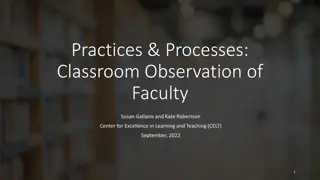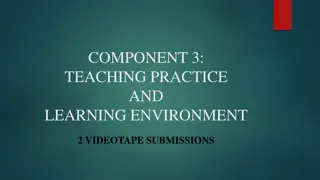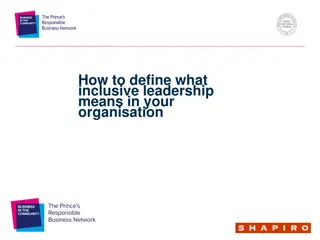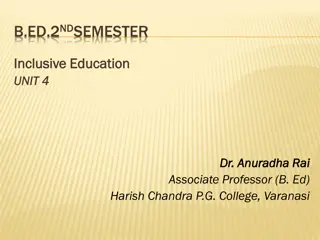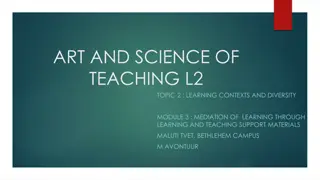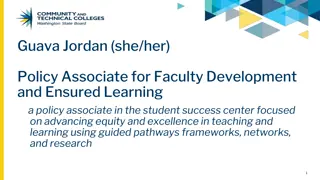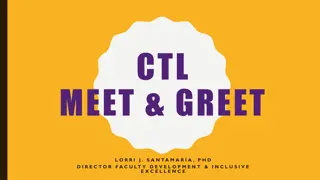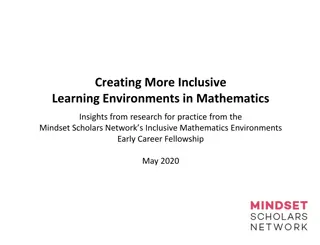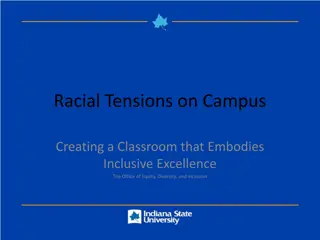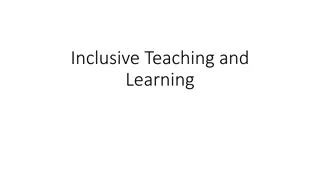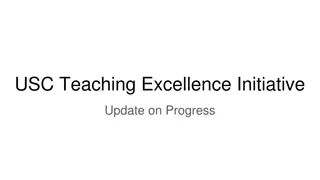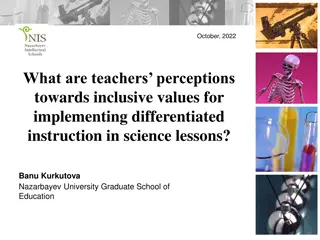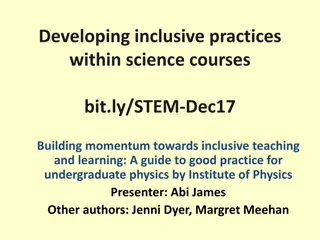Strategies for Inclusive Teaching Excellence in Modern Learning Environments
Design course elements for accessibility, set explicit student expectations for success, recognize diversity, and select content that acknowledges barriers to inclusion. Consider students' unique situations, promote community agreements, provide timely feedback, and offer diverse content to engage all learners effectively.
Download Presentation

Please find below an Image/Link to download the presentation.
The content on the website is provided AS IS for your information and personal use only. It may not be sold, licensed, or shared on other websites without obtaining consent from the author.If you encounter any issues during the download, it is possible that the publisher has removed the file from their server.
You are allowed to download the files provided on this website for personal or commercial use, subject to the condition that they are used lawfully. All files are the property of their respective owners.
The content on the website is provided AS IS for your information and personal use only. It may not be sold, licensed, or shared on other websites without obtaining consent from the author.
E N D
Presentation Transcript
Teaching with Excellence Teaching with Excellence in an in an Inclusive Classroom Inclusive Classroom Prepared by Elizabeth D. Palacios, Ph.D., Summer 2020
Design All Course Elements for Accessibility Be mindful of your students personal situations and barriers to their learning. Some students may be doing work on tablets/smartphones rather than computers. Reliable internet may be another issue. Be flexible with your students by recording your class, if possible, for those who might have missed your class due to technical difficulties. Ask for feedback periodically to make sure that your technology is working properly. Share PDFs instead of videos which require more bandwidth. Be aware of possible distractions and time management as students are learning from home among siblings, parents, etc.- encourage your students to find a quiet place; remind them of using virtual backgrounds to decrease distractions for the class. Remember some students find it difficult to stay motivated and engaged some students are working, taking care of siblings, etc.. Encourage them to stay connected with you and their classmates and share with you any change in their situations.
Set Explicit Student Expectations to Ensure Success for All of Your Students Create community agreements and guidelines for online discussion with students. This could take place in a shared Google Doc where online etiquette, norms, and expectations could be discussed. Create multiple, low-stakes assignments where students can demonstrate their skills and knowledge for online learning. This also encourages students to stay motivated. Provide timely feedback on your students work. Consider using audio and video comments which adds a personalized touch. Arrive early, if possible, to engage with learners.
Recognizes Diversity and Acknowledges Barriers to Inclusion Inclusive teaching is: - a mind-set. It is NOT synonymous with introducing diversity issues or current events, but rather offering diverse content, texts, and/or guest speakers relevant to the class. It is about the teaching structure and methods used in the classroom. - not hand-holding but rather providing structure for your students by being intentional and strategic. Although not all students require high structure, there may be others that need a scaffold to help them to develop their skills, knowledge, and voice. - not about redesigning your course, just considering tweaks that may make the difference of retaining a more diverse population of students in your discipline at Baylor!
Select Course Content that Recognizes Diversity and Acknowledges Barriers to Inclusion (cont d.) Students come to your classroom today with different cultural backgrounds, personalities, learning differences, and confidence levels. Just by sharpening the structure of your syllabus, assignments, tests, and pedagogy, all students can thrive. Avoid traditional teaching methods such as cold-calling to cull the weak students from the strong. This happens especially in STEM fields. This method overlooks students who may know the answers but are uncomfortable with raising their hands or blurting out answers. In some cultures, this may be seen as rude or disrespectful to the professor. Be comfortable with silence in your classroom. Small group and think-pair-share techniques are excellent in allowing introverts to share their thoughts. This would preclude some students monopolizing class discussions. Give plenty of time for thinking.
Select Course Content that Recognizes Diversity and Acknowledges Barriers to Inclusion (cont d) Invite students to find and share materials that may be found on the on the internet, including e-texts, journal articles, etc., that relate to course topics and reflect a range of perspectives and backgrounds. Critically evaluate the presentation of digital material. If you assign text or media that is problematic or includes stereotypes, point out the shortcomings and consider supplementing with other course materials. Encourage students to think critically about course material and related external sources to develop their information literacy skills.
Select Course Content that Recognizes Diversity and Acknowledges Barriers to Inclusion (cont d) In online discussions, recorded lectures, and live Zoom sessions (whether during class sessions or in office hours), use examples that speak across diverse populations. Draw on resources, materials, and anecdotes that are relevant to the subject and sensitive to the social and cultural diversity of your students. Connect with students personally. Use their names when interacting with them and be sure to learn the correct way to pronounce their names. Be prepared to have difficult dialogues by understanding and respecting differences. Model courage and commitment to authentic conversations while maintaining respect in the classroom. Inclusive teaching and learning really works!
Resources Baylor University Academy for Teaching and Learning. Diversity and Inclusion. https://www.baylor.edu/atl/index.php?id=942974 Columbia Center for Teaching and Learning. Inclusive Teaching Resources (includes MOOC, Guide, Accessibility resource) Columbia Center for Teaching and Learning. (2020). Asynchronous Learning Across Time Zones. Rice University. (2020). Inclusion, Equity, and Access While Teaching Remotely. Reflections on Teaching and Learning. The CTE Blog. Sathy, V. and Hogan, K. A. (2019). Want to Reach All of Your Students? Here s How to Make Your Teaching More Inclusive. The Chronicle of Higher Education. CIRTL Network. (2020). Teaching Inclusively in the Online, Synchronous Classroom. Center for the Integration of Research, Teaching and Learning.




